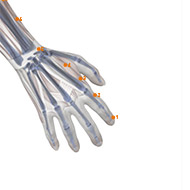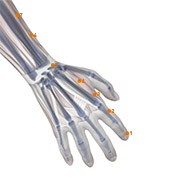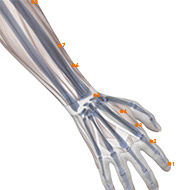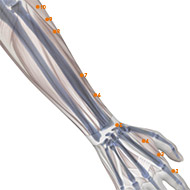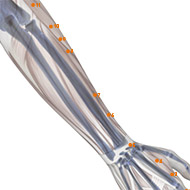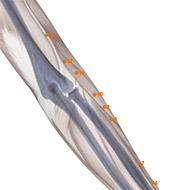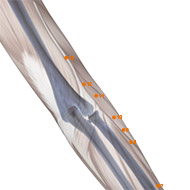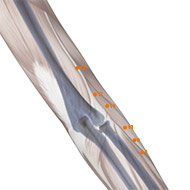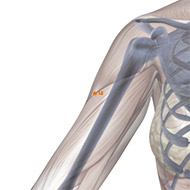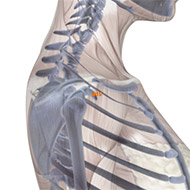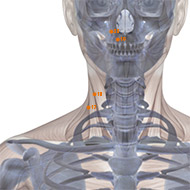The meridian system (simplified Chinese: 经络; traditional Chinese: 經絡; pinyin: jīngluò, also called channel network) is a concept in Traditional Chinese medicine (TCM) about a path through which the life-energy known as “qi” flows.1 The twelve standard meridians, also called principal meridians, are divided into Yin and Yang groups. The Yin meridians of the arm are Lung, Heart, and Pericardium. The Yang meridians of the arm are Large Intestine, Small Intestine, and Triple Burner. The Yin Meridians of the leg are Spleen, Kidney, and Liver. The Yang meridians of the leg are Stomach, Bladder, and Gall Bladder.2 The Large Intestine Meridian or Large Intestine Channel is one of the 12 principal meridians in TCM. It corresponds with the Taiyin Lung Meridian of the Hand. The Flow Hours of this meridian are 5:00 AM – 7:00 AM.3
CONTENTS
ORGAN AND FUNCTION
ACUPOINTS
FLOWING ROUTES
ORGAN AND FUNCTION
The large intestine (Chinese: 大肠/大腸: Pinyin: dà cháng) is one of the fu organs stipulated by traditional Chinese medicine (TCM). As distinct from the Western medical concept of large intestine, this concept from TCM is more a way of describing a set of interrelated parts than an anatomical organ. It is a functionally defined entity and not equivalent to the anatomical organ of the same name.4
The large intestine meridian communicates with the lung (肺), with which it is externally-internally related. The two paired organs are associated with the metal element (金) and the emotion of grief. The main function of the large intestine is to receive the waste material sent down from the small intestine, absorb its fluid content, and form the remainder into faeces to be excreted. Pathological changes of the large intestine will lead to dysfunction in this transportation function, resulting in loose stools and constipation.5
The large intestine’s function is said to be the strongest between 5 am and 7 am. The Large intestinal disease (dà cháng bìng) is attributable to heat, cold, stagnation, dampness, and wind, or to vacuity. Rumbling intestines or pain around the umbilicus, constipation or diarrhea, bloody stool or tenesmus with blood and pus in the stool, and prolapse of the rectum are signs of large intestine disease.6
ACUPOINTS
This meridian contains 20 acupoints in one side, that is 40 acupoints in total.
LI-1
Location: On the radial side of the index finger, about 0.1 cun posterior to the corner of the nail.
Indications: Toothache, sore throat, swelling of the submandibular region, numbness of fingers, febrile diseases with anhidrosis, loss of consciousness.
Acupuncture Method: Puncture 0.1 inch, or prick the point to cause bleeding.
Vasculature: The arterial and venous network formed by the dorsal digital arteries and veins.
Innervation: The palmar digital proprial nerve derived from the median nerve.
LI-2
Location: In the depression of the radial side of the index finger, distal to the 2nd metacarpal-phalangeal joint. The point is located with the finger slightly flexed.
Indications: Blurring of vision, Epistaxis, toothache, sore throat, febrile diseases.
Acupuncture Method: Puncture perpendicularly 0.2-0.3 inch. Moxibustion is applicable.
Vasculature: The dorsal digital and plamar digital propria 1 arteries and veins derived from the radial artery and vein.
Innervation: The dorsal digital nerve of the radial nerve, and the palmar digital proprial nerve of the median nerve.
LI-3
Location: When a loose fist is made, the point is on the radial side of the index finger, in the depression proximal to the head of the second metacarpal bone.
Indications: Toothache, ophthalmalgia, sore throat, redness and swelling of fingers and the dorsum of the hand.
Acupuncture Method: Puncture perpendicularly 0.5-0.8 inch. Moxibustion is applicable.
Vasculature: The dorsal venous network of the hand and the branch of the first dorsal metacarpal artery.
Innervation: The superficial ramus of the radial nerve.
LI-4
Location: On the dorsum of the hand, between the 1st and 2nd metacarpal bones; approximately in the middle of the 2nd metacarpal bone on the radial side.
Indications: Headache, pain in the neck, redness, swelling and pain of the eye, epistaxis, nasal obstruction, rhinorrhea, toothache, deafness, swelling of the face, sore throat, parotitis, trismus, facial paralysis, febrile diseases with anhidrosis, hidrosis, abdominal pain, dysentery, constipation, amenorrhea, delayed labour, infantile convulsion, pain, weakness and motor impairment of the upper limbs.
Acupuncture Method: Puncture perpendicularly 0.5-1 inch. Moxibustion is applicable.
Acupuncture and moxibustion are contraindicated in pregnant women.
Vasculature: The venous network of the dorsum of the hand.
Innervation: The superficial ramus of the radial nerve.
LI-5
Location: On the radial side of the wrist. When the thumb is tilted upward, it is in the depression between the tendons of m. extensor pollicis longus and brevis.
Indications: Headache, redness, pain and swelling of the eye, toothache, sore throat, pain of the wrist.
Acupuncture Method: Puncture perpendicularly 0.3-0.5 inch. Moxibustion is applicable.
Vasculature: The cephalic vein, the radial artery and its dorsal carpal branch.
Innervation: The superficial ramus of the radial nerve.
LI-6
Location: With the elbow flexed and the radial side of arm upward, the point is on the line joining Yangxi (LI-5) and Quchi (LI-11), 3 cun above the crease of the wrist.
Indications: Redness of the eye, tinnitus, deafness, epistaxis, aching of the hand and arm, sore throat, edema.
Acupuncture Method: Puncture perpendicularly or obliquely 0.5-0.8 inch. Moxibustion is applicable.
Vasculature: The cephalic vein.
Innervation: On the radial side, the lateral antebrachial cutaneous nerve and the superficial ramus of the radial nerve; on the ulnar side, the posterior antebrachial cutaneous nerve and the posterior antebrachial interosseous nerve.
LI-7
Location: With the elbow flexed and the radial side of arm upward, the point is on the line connecting Yangxi (LI-5) and Quchi (LI-11), 5 cun above the crease of the wrist.
Indications: Headache, swelling of the face, sore throat, borborygmus, abdominal pain, aching of the shoulder and arm.
Acupuncture Method: Puncture perpendicularly 0.5-1.0 inch. Moxibustion is applicable.
Vasculature: The muscular branch of the radial artery, the cephalic vein.
Innervation: The posterior antebrachial cutaneous nerve and the deep ramus of the radial nerve.
LI-8
Location: On the line joining Yangxi (LI-5) and Quchi (LI-11), 4 cun below the cubital crease.
Indications: Abdominal pain, borborygmus, pain in the elbow and arm, motor impairment of the upper limbs.
Acupuncture Method: Puncture perpendicularly 0.5-1.0 inch. Moxibustion is applicable.
Regional anatomy: See Wenliu (LI-7)
LI-9
Location: On the line joining Yangxi (LI-5) and Quchi (LI-11), 3 cun below the cubital crease.
Indications: Aching of the shoulder and arm, motor impairment of the upper limbs, numbness of the hand and arm, borborygmus, abdominal pain.
Acupuncture Method: Puncture perpendicularly 0.5-1.0 inch. Moxibustion is applicable.
Regional anatomy: See Wenliu (LI-7).
LI-10
Location: On the line joining Yangxi (LI-5) and Quchi (LI-11), 2 cun below the cubital crease.
Indications: Abdominal pain, diarrhea, toothache, swelling of the cheek, motor impairment of the upper limbs, pain in the shoulder and back.
Acupuncture Method: Puncture perpendicularly 0.8-1.2 inches. Moxibustion is applicable.
Vasculature: The branches of the radial recurrent artery and vein.
Innervation: See Wenliu (LI-7).
LI-11
Location: When the elbow is flexed, the point is in the depression at the lateral end of the transverse cubital crease, midway between Chize (LU-5) and the lateral epicondyle of the humerus.
Indications: Sore throat, toothache, redness and pain of the eye, scrofula, urticaria, motor impairment of the upper extremities, abdominal pain, vomiting, diarrhea, febrile diseases.
Acupuncture Method: Puncture perpendicularly 1.0-1.5 inches. Moxibustion is applicable.
Vasculature: The branches of the radial recurrent artery and vein.
Innervation: The posterior antebrachial cutaneous nerve; deeper, on the medial side, the radial nerve.
LI-12
Location: When the elbow is flexed, the point is on the lateral side of the upper arm, 1 cun above Quchi (LI-11), on the border of humerus.
Indications: Pain, numbness and contracture of the elbow and arm.
Acupuncture Method: Puncture perpendicularly 0.5-1.0 inch. Moxibustion is applicable.
Vasculature: The radial collateral artery and vein.
Innervation: The posterior antebrachial cutaneous nerve; deeper, on the medial side, the radial nerve.
LI-13
Location: On the lateral side of the upper arm, on the line connecting Quchi (LI-11) and Jianyu (LI-15), 3 cun above Quchi (LI-11).
Indications: Contracture and pain of the elbow and arm, scrofula.
Acupuncture Method: Puncture perpendicularly 0.5-1.0 inch. Avoid injuring the artery.
Moxibustion is applicable.
Vasculature: The radial collateral artery and vein.
Innervation: The posterior antebrachial cutaneous nerve; deeper, the radial nerve.
LI-14
Location: On the lateral side of the upper arm, on the line joining Quchi (LI-11) and Jianyu (LI-15), 7 cun above Quchi (LI-11), at the insertion of m. deltoideus.
Indications: Pain in the shoulder and arm, rigidity of the neck, scrofula.
Acupuncture Method: Puncture perpendicularly or obliquely upward 0.8-1.5 inches. Moxibustion is applicable.
Vasculature: The branches of posterior circumflex humeral artery and vein, the deep brachial artery and vein.
Innervation: The posterior brachial cutaneous nerve; deeper, the radial nerve.
LI-15
Location: Antero-inferior to the acromion, on the upper portion of m. deltoideus. When the arm is in full abduction, the point is in the depression appearing at the anterior border of the acromioclavicular joint.
Indications: Pain in the shoulder and arm, motor impairment of the upper extremities, rubella, scrofula.
Acupuncture Method: Puncture perpendicularly or obliquely 0.8-1.5 inches. Moxibustion is applicable.
Vasculature: The posterior circumflex artery and vein.
Innervation: The lateral supraclavicular nerve and axillary nerve.
LI-16
Location: In the upper aspect of the shoulder, in the depression between the acromial extremity of the clavicle and the scapular spine.
Indications: Pain and motor impairment of the upper extremities, pain in the shoulder and back.
Acupuncture Method: Puncture perpendicularly 0.5-0.7 inch. Moxibustion is applicable.
Vasculature: Deeper, the suprascapular artery and vein.
Innervation: Superficially, the lateral supraclavicular nerve, the branch of the accessory nerve; deeper, the suprascapular nerve.
LI-17
Location: On the lateral side of the neck, at the posterior border of sternocleidomastoid muscle, beside the laryngeal protuberance, at the midpoint of the line connecting Futu (LI-18) and Quepen (ST-12).
Indications: Sudden loss of voice, sore throat, scrofula, goiter.
Acupuncture Method: Puncture perpendicularly 0.3-0.5 inch. Moxibustion is applicable.
Vasculature: The external jugular vein.
Innervation: Superficially, the supraclavicular nerve. It is on the posterior border of m. sternocleido- mastoideus just where the cutaneous cervical nerve emerges. Deeper, the phrenic nerve.
LI-18
Location: On the lateral side of the neck, level with the tip of Adam’s apple, between the sternal head and clavicular head of m. sternocleidomastoideus.
Indications: Cough, asthma, sore throat, sudden loss of voice, scrofula, goiter.
Acupuncture Method: Puncture perpendicularly 0.3-0.5 inch. Moxibustion is applicable.
Vasculature: Deeper, on the medial side, the ascending cervical artery and vein.
Innervation: The great auricular nerve, cutaneous cervical nerve, lesser occipital nerve and accessory nerve.
LI-19
Location: Right below the lateral margin of the nostril, level with Renzhong (Shuigou, GV-26).
Indications: Nasal obstruction, epistaxis, deviation of the mouth.
Acupuncture Method: Puncture obliquely 0.2-0.3 inch.
Vasculature: The superior labial branches of the facial artery and vein.
Innervation: The anastomotic branch of the facial nerve and the infraorbital nerve.
LI-20
Location: In the nasolabial groove, at the level of the midpoint of the lateral border of ala nasi.
Indications: Nasal obstruction, hyposmia, epistaxis, rhinorrhea, deviation of the mouth, itching and swelling of the face.
Acupuncture Method: Puncture obliquely or subcutaneously 0.3-0.5 inch.
Vasculature: The facial artery and vein, the branches of the infraorbital artery and vein.
Innervation: The anastomotic branch of the facial and infraorbital nerves.
FLOWING ROUTES
This meridian originates from the radial tip of the index finger (Shangyang, LI-1). It ascends through Hegu (LI-4), runs upwards along the anterior border of the lateral side of the upper limb to the shoulder, and emerges from the anterior edge of the acromion, where it goes back to the seventh cervical vertebra (Dazhui, GV-14). Then descending, from the supraclavicular fossa (Quepen, ST-12) enters the thoracic cavity to link with the lung. Then, passing through the diaphragm, it enters the large intestine to which it pertains.
Its branch goes up from the supraclavicular fossa (Quepen,ST-12) and passes through the neck to the cheek, entering the gums of the lower teeth. Then, it curves around the upper lip and crosses the opposite meridian at the philtrum and upward to the opposite nosewing (Yingxiang, LI-20) to connect with the yangming stomach meridian of the foot.7
Footnotes
- What Is Traditional Chinese Medicine – sciencebasedmedicine.org – 2012, https://sciencebasedmedicine.org/what-is-traditional-chinese-medicine/
- Advanced Pressure Point Fighting of Ryukyu Kempo – A Dillman Karate International Book – 1994, https://www.amazon.com/Advanced-Pressure-Point-Fighting-Ryukyu/dp/0963199633/
- Acupuncture points of the large intestine meridian of the hand – cnacupuncture.com – 2017, http://www.cnacupuncture.com/points-of-the-large-intestine-meridian-of-hand-yangming.html
- Chinese natural cures – Black Dog & Leventhal Publishing – 1994, https://www.abebooks.com/book-search/isbn/1579120563/
- Chinese acupuncture and moxibustion – Foreign Languages Press – 1987, https://www.amazon.com/Chinese-Acupuncture-Moxibustion-Seventeenth-Printing/dp/7119059947/ref=sr_1_1?s=books&ie=UTF8&qid=1493125663&sr=1-1
- The foundations of chinese medicine: a comprehensive text for acupuncturists and herbalists – Black Dog & Elsevier Churchill Livingstone – 2005, https://www.amazon.com/Foundations-Chinese-Medicine-Comprehensive-Acupuncturists/dp/0443074895
- Yangming Large Intestine Meridian of the Hand – tcmwiki.com – 2017, https://tcmwiki.com/wiki/yangming-large-intestine-meridian-of-hand
LU01
LU02
LU03
LU04
LU05
LU06
LU07
LU08
LU09
LU10
LU11
LI01
LI02
LI03
LI04
LI05
LI06
LI07
LI08
LI09
LI10
LI11
LI12
LI13
LI14
LI15
LI16
LI17
LI18
LI19
LI20
ST01
ST02
ST03
ST04
ST05
ST06
ST07
ST08
ST09
ST10
ST11
ST12
ST13
ST14
ST15
ST16
ST17
ST18
ST19
ST20
ST21
ST22
ST23
ST24
ST25
ST26
ST27
ST28
ST29
ST30
ST31
ST32
ST33
ST34
ST35
ST36
ST37
ST38
ST39
ST40
ST41
ST42
ST43
ST44
ST45
SP01
SP02
SP03
SP04
SP05
SP06
SP07
SP08
SP09
SP10
SP11
SP12
SP13
SP14
SP15
SP16
SP17
SP18
SP19
SP20
SP21
HT01
HT02
HT03
HT04
HT05
HT06
HT07
HT08
HT09
SI01
SI02
SI03
SI04
SI05
SI06
SI07
SI08
SI09
SI10
SI11
SI12
SI13
SI14
SI15
SI16
SI17
SI18
SI19
BL01
BL02
BL03
BL04
BL05
BL06
BL07
BL08
BL09
BL10
BL11
BL12
BL13
BL14
BL15
BL16
BL17
BL18
BL19
BL20
BL21
BL22
BL23
BL24
BL25
BL26
BL27
BL28
BL29
BL30
BL31
BL32
BL33
BL34
BL35
BL36
BL37
BL38
BL39
BL40
BL41
BL42
BL43
BL44
BL45
BL46
BL47
BL48
BL49
BL50
BL51
BL52
BL53
BL54
BL55
BL56
BL57
BL58
BL59
BL60
BL61
BL62
BL63
BL64
BL65
BL66
BL67
KD01
KD02
KD03
KD04
KD05
KD06
KD07
KD08
KD09
KD10
KD11
KD12
KD13
KD14
KD15
KD16
KD17
KD18
KD19
KD20
KD21
KD22
KD23
KD24
KD25
KD26
KD27
PC01
PC02
PC03
PC04
PC05
PC06
PC07
PC08
PC09
TB01
TB02
TB03
TB04
TB05
TB06
TB07
TB08
TB09
TB10
TB11
TB12
TB13
TB14
TB15
TB16
TB17
TB18
TB19
TB20
TB21
TB22
TB23
GB01
GB02
GB03
GB04
GB05
GB06
GB07
GB08
GB09
GB10
GB11
GB12
GB13
GB14
GB15
GB16
GB17
GB18
GB19
GB20
GB21
GB22
GB23
GB24
GB25
GB26
GB27
GB28
GB29
GB30
GB31
GB32
GB33
GB34
GB35
GB36
GB37
GB38
GB39
GB40
GB41
GB42
GB43
GB44
LV01
LV02
LV03
LV04
LV05
LV06
LV07
LV08
LV09
LV10
LV11
LV12
LV13
LV14
GV01
GV02
GV03
GV04
GV05
GV06
GV07
GV08
GV09
GV10
GV11
GV12
GV13
GV14
GV15
GV16
GV17
GV18
GV19
GV20
GV21
GV22
GV23
GV24
GV25
GV26
GV27
GV28
CV01
CV02
CV03
CV04
CV05
CV06
CV07
CV08
CV09
CV10
CV11
CV12
CV13
CV14
CV15
CV16
CV17
CV18
CV19
CV20
CV21
CV22
CV23
CV24




